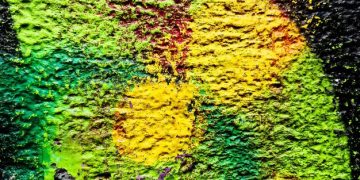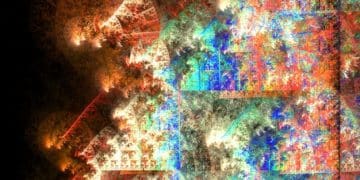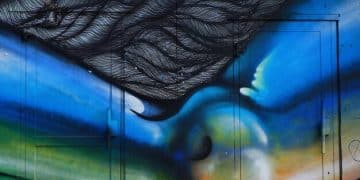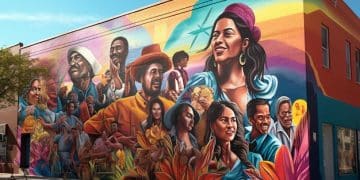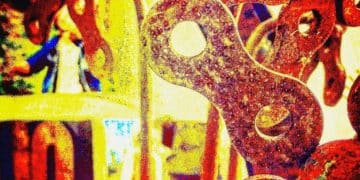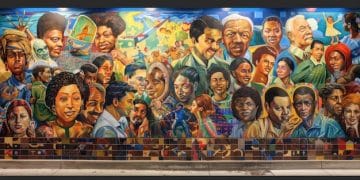Graffiti Art Preservation: Can New Coating Technologies Extend Mural Life by 50%?
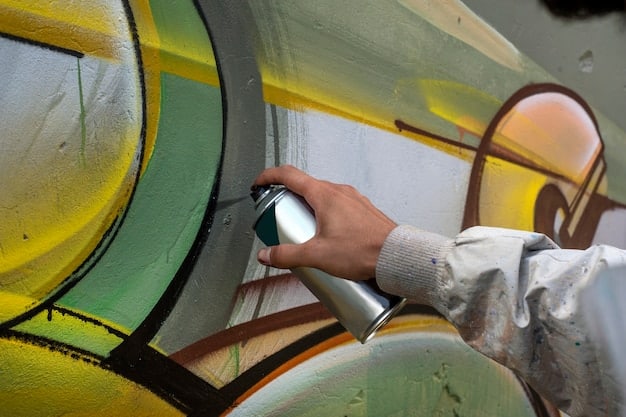
New coating technologies hold significant promise for Graffiti Art Preservation, potentially extending the vibrancy and structural integrity of murals by 50% or more through advanced protective layers, UV resistance, and environmental durability.
The ephemeral nature of street art, while core to its raw appeal, poses a significant challenge for long-term urban aesthetics and cultural patrimony. Can Graffiti Art Preservation: Can New Coating Technologies Extend the Life of Murals by 50%? This question is at the forefront of conservation efforts, seeking to bridge the gap between artistic expression and environmental resilience, ensuring these vibrant public canvases endure for future generations.
The Ephemeral Canvas: Challenges in Graffiti Mural Longevity
Graffiti murals, by their very design, are exposed to a myriad of environmental adversaries. Unlike gallery art, they contend with direct sunlight, fluctuating temperatures, rainfall, and airborne pollutants. These elements conspire to degrade pigments, crack paint layers, and diminish the artwork’s visual impact over time.
Furthermore, human-induced threats are a constant concern. Vandalism, accidental damage, and even well-intentioned but improper cleaning attempts can accelerate a mural’s decay. The urban fabric itself, with its constant construction, demolition, and infrastructure changes, often puts murals at risk of being painted over or destroyed.
Environmental Degradation Factors
Sunlight, particularly its ultraviolet (UV) component, is a primary culprit. UV radiation breaks down chemical bonds in organic pigments, leading to color fading and chalking. Temperature swings cause expansion and contraction of the substrate and paint layers, resulting in micro-cracks that allow moisture ingress and further damage.
- UV radiation causes pigment fading and chalking.
- Temperature fluctuations lead to cracking and delamination.
- Rain and humidity foster mold growth and water damage.
Rainfall introduces moisture, which can lead to efflorescence on porous surfaces, mold and mildew growth, and the overall weakening of the paint bond to the wall. Airborne pollutants, such as vehicle exhaust and industrial emissions, deposit soot and acidic particles that stain and chemically alter the mural surface.
Human and Urban Threats
While often celebrated, graffiti murals exist in a dynamic urban landscape. Accidental damage from construction, utility work, or even public interaction is common. Poorly executed restoration attempts or attempts by individuals to ‘clean’ a mural without proper knowledge can also inflict irreversible harm. The inherent tension between the transient nature of street art and the desire for its preservation is a complex challenge that requires nuanced solutions.
The financial and logistical burden of constant maintenance is also a significant barrier. Municipalities and art organizations often lack the resources to address the rapid deterioration of murals, making proactive protection crucial. Understanding these myriad threats is the first step in developing effective preservation strategies.
Understanding Current Preservation Methods: A Foundation
Traditional approaches to preserving graffiti murals have evolved significantly, moving beyond simple repainting to more specialized conservation techniques. These methods aim to mitigate the effects of environmental exposure and human interference, though they often come with their own set of limitations and costs. Before advanced coatings, physical barriers, regular maintenance, and restorative techniques were the primary tools.
Physical barriers, such as clear panels or fences, have been employed, but they often detract from the artwork’s accessibility and visual appeal. While offering a degree of protection against direct abrasion or tagging, they can create an unwanted barrier between the art and its audience, fundamentally altering the artwork’s public nature.
Traditional Restoration Techniques
Cleaning, consolidation, and retouching are common restorative measures. Cleaning removes surface grime, pollutants, and previous layers of graffiti. Consolidation aims to strengthen flaking or delaminating paint layers. Retouching involves carefully re-painting faded or damaged areas to match the original artwork, a highly skilled and often expensive process.
- Regular cleaning to remove superficial dirt and grime.
- Consolidation of unstable paint layers to prevent loss.
- Careful retouching by trained conservators to restore vibrancy.
However, these methods are reactive rather than proactive. They address damage after it has occurred, often requiring specialized expertise and significant financial investment. The cumulative effect of repeated interventions can also alter the original artwork’s appearance or integrity over time, making a robust, preventive measure highly desirable.
The Role of Anti-Graffiti Coatings
Even before the advent of advanced nanotechnology, “anti-graffiti” coatings existed. These typically formed a sacrificial layer over the mural that allowed new graffiti to be removed without damaging the underlying artwork. While effective against subsequent tagging, many of these earlier coatings lacked comprehensive protection against environmental factors like UV degradation or atmospheric pollution, and their aesthetic properties could sometimes alter the mural’s original finish, making them less ideal for preserving the art itself.
Their major limitation was often their inability to protect against the very environmental elements that cause most long-term damage, such as UV radiation and moisture penetration. They were primarily a solution for repeated vandalism, not for extending the inherent lifespan of the mural’s pigments and substrate. This gap highlights the need for truly “protective” coatings that go beyond mere anti-graffiti properties to offer comprehensive environmental safeguarding.
The Promise of New Coating Technologies: A Paradigm Shift
The advent of new coating technologies, driven largely by advancements in materials science and nanotechnology, represents a significant leap forward in mural preservation. These next-generation coatings are designed to offer multi-faceted protection, addressing not only vandalism but also the more insidious forces of environmental degradation that cause long-term decay. The potential for extending a mural’s life by 50% or more hinges on these innovative formulations.
At the core of these innovations are materials that exhibit superior resistance to UV light, hydrophobic (water-repellent) properties, and enhanced durability against abrasion and chemical attacks. Unlike previous coatings that often formed a thick, visible layer, many new coatings are designed to be virtually imperceptible, maintaining the mural’s original aesthetic integrity.
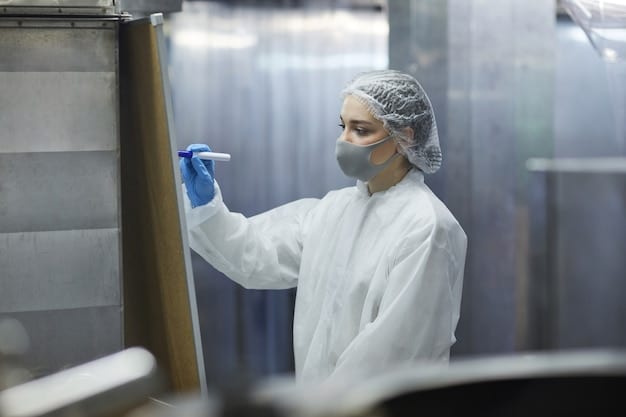
Nanotechnology in Preservation
Nanotechnology plays a pivotal role in these advancements. Nanoparticles, due to their extremely small size, can create highly dense, uniform, and robust protective layers that conventional coatings cannot achieve. These particles can be engineered to specifically block UV radiation, repel water at a molecular level, and resist the adhesion of pollutants and new graffiti.
- Nano-ceramic coatings for extreme hardness and UV stability.
- Self-cleaning (photocatalytic) coatings using titanium dioxide.
- Hydrophobic nanoparticle treatments to repel water and grime.
For instance, nano-ceramic coatings can offer exceptional hardness and scratch resistance, while also providing a barrier against chemical agents. Similarly, coatings infused with photocatalytic nanoparticles, like titanium dioxide, can actively break down airborne pollutants and organic matter when exposed to light, offering a self-cleaning effect that reduces the need for manual maintenance.
Hydrophobic and Oleophobic Properties
Many new coatings are designed to be highly hydrophobic (water-repellent) and oleophobic (oil-repellent). This means that water, oils, and other liquid contaminants bead up and roll off the surface, taking dirt and pollutants with them. This “lotus effect” significantly reduces the chances of water damage, mold growth, and the embedding of grime into the paint layers, keeping the mural cleaner for longer and simplifying maintenance.
This repellency also makes it significantly harder for spray paint or markers to adhere to the surface, allowing for easy removal of new graffiti without damaging the underlying artwork, often with just water or mild solvents. This combination of protective features makes these coatings far more effective than their predecessors in safeguarding murals against both wear and deliberate damage.
Key Technologies Driving Extended Mural Lifespans
Several distinct coating technologies are at the forefront of extending mural lifespans, each offering unique benefits that contribute to overall preservation. These advancements are not merely incremental improvements but represent a strategic shift towards more durable, reactive, and aesthetically sympathetic solutions. By combining the best attributes of these technologies, it becomes feasible to reach and even exceed the goal of a 50% extension in mural life.
UV-Resistant and Anti-Fading Coatings
One of the primary agents of mural degradation is UV radiation. New coatings incorporate advanced UV absorbers and blockers that significantly reduce the amount of harmful radiation reaching the paint pigments. These include organic UV absorbers that convert UV energy into heat, and inorganic pigments like zinc oxide or titanium dioxide (at nanoparticles level) that reflect and scatter UV light.
These coatings also often include hindered amine light stabilizers (HALS), which scavenge free radicals formed by UV exposure, preventing the breakdown of polymer chains in the paint and coating itself. By mitigating photodegradation, these coatings dramatically slow down color fading and chalking, preserving the mural’s original vibrancy for decades.
Self-Cleaning (Photocatalytic) Coatings
Self-cleaning coatings, often based on titanium dioxide (TiO2) nanotechnology, represent a revolutionary approach to maintenance. When exposed to light, TiO2 acts as a photocatalyst, reacting with oxygen and water vapor in the air to produce highly reactive hydroxyl radicals and superoxide ions. These powerful oxidizing agents break down organic pollutants, dirt, and even some forms of biological growth into harmless CO2 and water.
- Breaks down organic pollutants and dirt.
- Reduces the frequency and intensity of cleaning.
- Maintains the mural’s aesthetic appeal over time.
Simultaneously, these coatings develop superhydrophilic properties (highly water-attractive) when wet, allowing rain to spread evenly across the surface and wash away the decomposed grime. This dual action significantly reduces the need for manual cleaning, saving resources and preventing potential damage from abrasive cleaning methods.
Anti-Graffiti and Easy-Clean Coatings
While traditional anti-graffiti coatings existed, new easy-clean coatings leverage advanced polymer chemistry and fluoropolymer technology to create surfaces that are extremely low-friction and non-stick. These “release” coatings prevent spray paints, markers, and adhesives from bonding strongly to the mural surface. This allows for swift and complete removal of new graffiti using only water, mild pressure washing, or minimal chemical intervention, without damaging the underlying artwork.
The key difference is their exceptional durability and transparency, coupled with their dual function of protecting against environmental factors. Older anti-graffiti solutions often compromised the mural’s original appearance or offered limited environmental resistance. Modern solutions provide a robust, invisible shield that addresses both vandalism and natural decay without aesthetic compromise.
Case Studies and Real-World Applications
While the full 50% life extension still requires long-term observation, early applications and pilot projects of these new coating technologies on graffiti murals and other public artworks are yielding promising results. These real-world case studies provide valuable insights into the practical benefits and challenges of deploying advanced preservation solutions in diverse urban environments.
Across various cities, artistic and municipal entities are experimenting with these coatings to protect significant public artworks. These projects often involve applying the chosen coating to a section of a mural or an entire piece and then monitoring its performance over several years against both environmental wear and potential vandalism.
Early Successes in Urban Preservation
In cities like Berlin, Melbourne, and Los Angeles, experimental applications of advanced hydrophobic and UV-resistant coatings have shown noticeable improvements in mural longevity. Murals treated with these new technologies have retained their color vibrancy for longer periods compared to untreated sections or adjacent older murals. Maintenance teams report easier cleaning of grime and successful removal of new tags with minimal effort.
For example, a pilot project on a prominent mural in a high-traffic area demonstrated that a nano-fluoro polymer coating significantly reduced the adhesion of spray paint, allowing for repeated removal of new graffiti without ghosting or loss of the original artwork. The mural also exhibited enhanced resistance to rainwater staining and atmospheric pollutants, maintaining its crisp appearance.
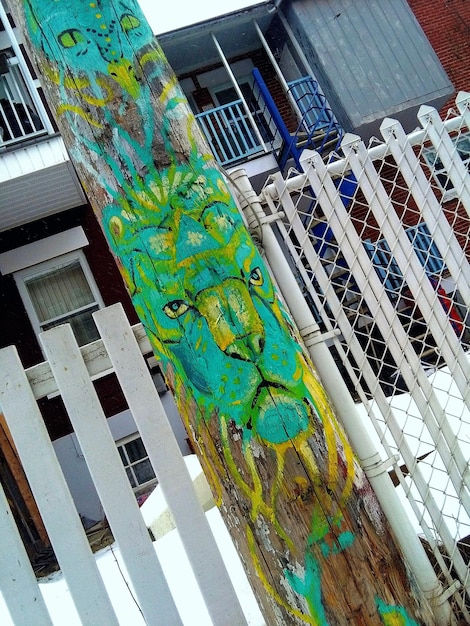
Challenges and Future Considerations
Despite the successes, challenges remain. The initial application cost of these advanced coatings can be higher than traditional sealants, though this is often offset by reduced long-term maintenance expenses. Compatibility with diverse mural substrates (concrete, brick, stucco) and varying paint types (aerosol, acrylic, latex) requires careful assessment to ensure optimal adhesion and performance.
Moreover, the long-term environmental impact of some chemical formulations needs continuous monitoring, though many manufacturers are prioritizing eco-friendly and non-toxic compositions. Scaling up these applications to protect a vast network of urban murals requires significant collaboration between artists, conservators, material scientists, and city authorities.
These case studies underscore the transformative potential of new coating technologies. While quantitative data on a 50% life extension is still being gathered over time, the qualitative evidence of enhanced durability, improved aesthetic retention, and simplified maintenance is compelling. The future of graffiti mural preservation looks significantly brighter with these innovations at the forefront.
Quantifying the 50% Gain: A Realistic Outlook
The question of whether new coating technologies can extend the life of murals by 50% is ambitious, yet increasingly realistic. This isn’t just about preventing tagging; it’s about fundamentally slowing down the natural processes of decay. Quantifying this extension requires a clear understanding of what “life” means in this context and how these advanced materials directly counteract the forces of degradation.
Measuring a 50% life extension is complex, as mural longevity depends on numerous variables including location, climate, substrate quality, and initial paint quality. However, by focusing on key degradation indicators, we can project the impact of these coatings. “Life” here refers to the period during which the mural retains its artistic integrity, color vibrancy, and structural soundness without requiring major restorative interventions.
Metrics for Measuring Longevity
To quantify the extension, conservators and material scientists track several key metrics:
- Color Fidelity: Using spectrophotometry to measure color degradation (fading, shifting) over time.
- Surface Integrity: Assessing cracking, chalking, delamination, and efflorescence.
- Cleanability: Measuring the ease and effectiveness of graffiti removal without damaging the underlying art.
- Maintenance Cycles: Documenting the frequency and intensity of required cleaning and repairs.
If a mural typically requires significant restoration every 10 years due to environmental fading and structural issues, a 50% extension would mean pushing that timeline to 15 years. This hypothetical extension directly translates into significant cost savings for maintenance and preservation efforts, whilst maintaining public visual assets effectively.
How New Coatings Contribute to Longevity
New coatings primarily achieve this extension by:
1. Superior UV Protection: By blocking a higher percentage of UV radiation, these coatings drastically slow down pigment fading, which is often the most visible sign of a mural’s aging. This directly addresses the main cause of aesthetic degradation.
2. Enhanced Hydrophobicity: Preventing water ingress into the paint layers and substrate significantly reduces issues like mold growth, efflorescence, and freeze-thaw damage, preserving the structural integrity of the paint and wall.
3. Decreased Adhesion for Vandalism: Making future graffiti easier to remove means less abrasive cleaning is needed, preventing cumulative damage to the original artwork with each tagging event. This protective layer ensures that the art is not mechanically damaged during the cleaning process.
4. Reduced Soiling and Bio-Growth: Self-cleaning properties or advanced barrier properties minimize the accumulation of dirt, pollutants, and biological contaminants, reducing the need for harsh chemicals or physical scrubbing that could compromise the art.
Considered cumulatively, these protections diminish the rate of degradation on multiple fronts. While a definitive 50% extension for every mural and every coating is a broad claim, the scientific principles and early performance data strongly suggest that many murals, particularly those in challenging environments, can indeed see their lifespan dramatically prolonged. This brings the ambitious goal within tangible reach.
Implementation Challenges and Ethical Considerations
While the technological promise of new coatings for graffiti mural preservation is immense, their widespread implementation is not without significant challenges and important ethical considerations. Balancing the desire for longevity with the inherent transient nature of street art, alongside practical and financial hurdles, demands careful navigation.
The decision to apply a protective coating to a mural, especially an unsanctioned one, raises questions about artistic intent and public accessibility. Artists often consider their work to be temporary, part of an ongoing dialogue with the urban environment that includes inevitable decay or alteration.
Practical Hurdles
One major practical challenge is the cost. While new coatings can save money on long-term maintenance, their initial application can be expensive, requiring specialized equipment and skilled labor. For municipalities or non-profit art organizations, securing funding for mass application across numerous murals can be a significant barrier.
- High initial application costs.
- Need for specialized application techniques and equipment.
- Compatibility issues with diverse substrates and original paint types.
Another hurdle is the sheer scale. Many cities boast hundreds, if not thousands, of murals. A comprehensive preservation program would require substantial logistical planning and resources. Furthermore, the varying chemical compositions of different artists’ paints and the diverse nature of urban surfaces (concrete, brick, metal, wood) mean that a single “one-size-fits-all” coating solution may not always be effective or appropriate for every mural.
Ethical Dilemmas in Preservation
Should all graffiti murals be permanently preserved? Many street artists embrace the idea that their work is ephemeral, a fleeting statement in time. Applying a permanent coating against the artist’s wishes, or without their knowledge, could be seen as a violation of their artistic integrity or the original intent of the work. This highlights the importance of artist involvement and community consent in preservation decisions.
There’s also the question of authenticity. Does a coated mural retain its “original” essence, or does the protective layer fundamentally alter the artwork? Some purists argue that any intervention, even for preservation, detracts from the true nature of street art. These ethical considerations demand a nuanced approach, often requiring a case-by-case assessment and open dialogue with artists, communities, and conservation experts to ensure that technology serves art responsibly.
The Future of Graffiti Preservation: Beyond Coatings
Looking ahead, the future of graffiti mural preservation extends beyond just advanced coatings. While these new technologies are pivotal, a holistic approach that integrates community engagement, digital archiving, and intelligent urban planning will define how we interact with and safeguard street art in the decades to come. The goal is not merely to freeze a mural in time, but to manage its lifecycle thoughtfully.
Community involvement is crucial. Local residents, artists, and cultural organizations often have the deepest connection to murals and can play a vital role in their care. Educational programs about the importance of preservation and the impact of vandalism can foster a sense of shared responsibility.
Digital Archiving and Documentation
Beyond physical preservation, digital archiving offers a complementary and increasingly important layer of conservation. High-resolution photography, 3D scanning, and virtual reality platforms can create immersive digital replicas of murals. This ensures that even if a mural is eventually lost to time or urban development, its essence and details are preserved for posterity and academic study.
- High-resolution photographic documentation.
- 3D scanning for detailed spatial records.
- Virtual reality experiences to virtually “visit” lost murals.
Digital archives serve not only as historical records but also as educational tools, allowing broader access to art that might otherwise be geographically limited or physically vulnerable. This approach acknowledges the transient nature of some murals while ensuring their cultural legacy endures.
Strategic Urban Planning and Policy
Integrating mural preservation into urban planning and policy frameworks is another critical step. This can involve designating “mural zones” where art is encouraged and protected, developing clear guidelines for public art maintenance, and allocating dedicated funding for conservation efforts. Policies that recognize street art as a valuable cultural asset can foster a more supportive environment for its longevity.
Ultimately, the future of graffiti preservation is a multifaceted endeavor that combines cutting-edge material science with thoughtful community engagement and long-term strategic planning. New coating technologies provide a powerful tool, but they are most effective when part of a broader, more integrated approach that recognizes the complex value of urban art.
| Key Aspect | Brief Description |
|---|---|
| 🛡️ Advanced Coatings | Next-gen coatings (nano-tech, UV-resistant) significantly slow environmental degradation. |
| 🎨 Mural Longevity | Potential for 50%+ life extension by preserving color, integrity, and resisting vandalism. |
| 🧪 Key Technologies | UV blockers, self-cleaning (TiO2), hydrophobic/oleophobic properties are crucial. |
| 🌍 Holistic Approach | Beyond coatings: community, digital archiving, and urban planning are also vital. |
Frequently Asked Questions
▼
Graffiti murals face threats from UV radiation causing fading, temperature fluctuations leading to cracking, water damage, airborne pollutants, and human factors such as vandalism, accidental damage, and improper cleaning attempts. Urban development also poses risks to their existence.
▼
New coatings use advanced materials like nanoparticles to provide superior UV blocking, water repellency (hydrophobicity), self-cleaning properties, and enhanced durability against abrasion and chemical attacks. These features collectively slow down decay and make maintenance easier, prolonging the mural’s vibrancy.
▼
Many modern coating technologies are designed to be virtually imperceptible, maintaining the mural’s original aesthetic and finish. Unlike older, thicker sealants, these advanced formulations aim for transparency to preserve the artist’s original intent and the artwork’s visual impact.
▼
Challenges include the higher initial cost of application, the need for specialized application techniques, ensuring compatibility with diverse mural substrates and paint types, and the ethical considerations surrounding artists’ intent regarding the ephemeral nature of their work. Scaling up for widespread use is also complex.
▼
While definitive long-term data is still being gathered, early real-world applications and scientific principles suggest a 50% or greater extension is realistically achievable. By mitigating key degradation factors like UV damage and enabling easier cleaning, these coatings significantly slow down the aging process of murals.
Conclusion
The quest for tangible longevity in graffiti art, traditionally defined by its fleeting nature, finds compelling answers in the advancements of new coating technologies. The aspiration of extending mural life by 50% or more is demonstrably within reach, anchored by innovations that effectively combat environmental degradation and simplify vandalism removal. While challenges persist in implementation, and ethical considerations demand thoughtful dialogue, the transformative potential of these materials offers an exciting future. By integrating scientific progress with community stewardship and forward-thinking urban planning, we can ensure that the vibrant stories told on our city walls continue to inspire and enrich generations to come, preserving a powerful form of public art for decades beyond traditional expectations.
